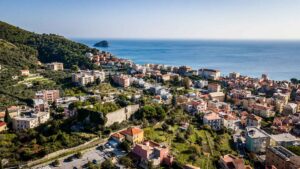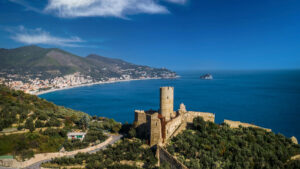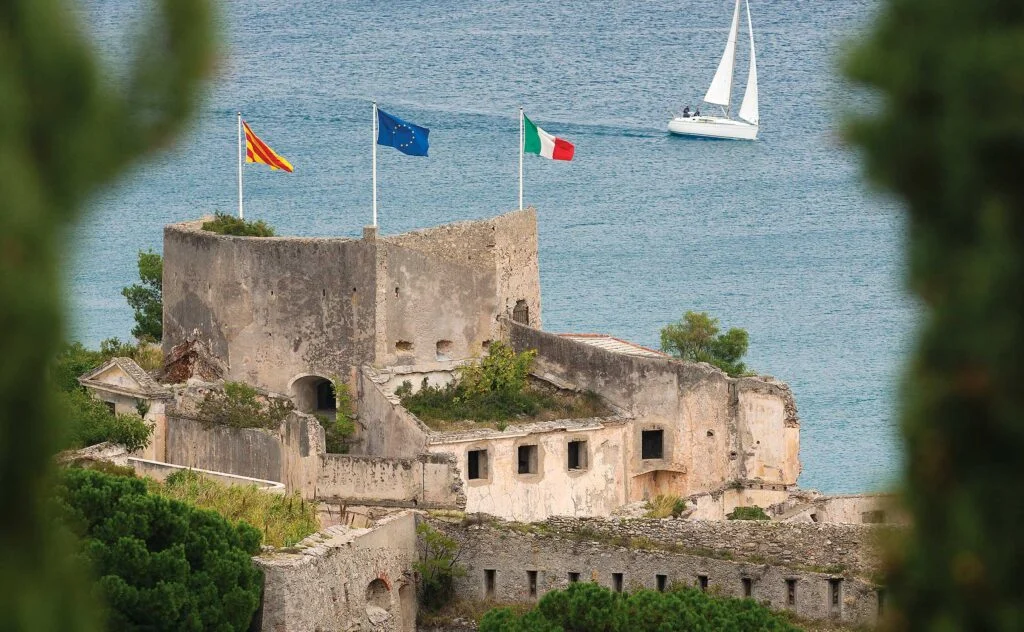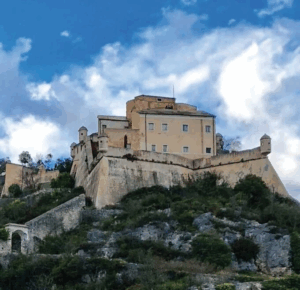CASTLES IN SPOTORNO AND NEARBY
The castle of Spotorno: history and features
The Castle of Spotorno it represents one of the main military fortifications of the area, built on a hill to ensure strategic control of the coast. The structure, with a rectangular plan, is made of mixed masonry of stone and bricks, with evidence of walkways and arrow slits – defensive openings from which objects or boiling liquids were thrown at the attackers. The castle stands on bare rock, on a relief opposite to that of the Torre Coreallo.
Although its origins are not completely documented, it is mentioned as early as 1180 as property of the diocese of Savona. Its history has been quite troubled: destroyed by the nearby city of Noli after 1180, it was rebuilt in 1218, but again demolished in 1227, probably at the behest of the Republic of Genoa.
A third reconstruction took place between the 14th and 15th centuries. From 1333, the castle was owned by the Municipality of Savona and later by the De Loterio family, who maintained it until World War I.
Today, the castle is in a state of abandonment, despite having been the subject of archaeological studies in the last century. In 2016, a conference promoted by the Municipality of Spotorno and local cultural organizations, with the participation of Professor Carlo Varaldo, brought attention back to the excavations and the history of the site. With appropriate initiatives, the Castle of Spotorno could become one of the main tourist attractions of the city in the future.
Visit the website “Il golfo dell’isola” for more information of the castle and on visits to the city.
The Castle of Monte Ursino in Noli: history, visit, and how to reach it
The Castle of Monte Ursino, located on a hill in Noli, It dates back to the 9th century. After a fire devastated the town, following the example of other coastal communities, the inhabitants decided to build a fortification in an elevated position to ensure more effective defense, without abandoning their maritime tradition. The construction was financed by the powerful Del Carretto family, of Aleramic origin.

Initially, a large circular tower was erected, capable of housing troops, stables, kitchens, and warehouses. Around this nucleus, a defensive wall was built to protect the agricultural terraces of the hill.
The strategic position allowed for the control of both the coastline and the Roman road that passed through Voze, under the jurisdiction of Noli.
To protect itself from attacks by nearby centers, Noli allied with Genoa in 1202. The castle had an ingenious defensive structure: an outer tower connected by a walkway that allowed defenders to strike attackers before they reached the city gates.
Today, the Monte Ursino Castle is one of the main attractions of Noli. Open to visitors (including those accompanied by pets), the walk takes about 30 minutes and offers the chance to admire period armor and a stunning view of the Gulf.
The enhancement of the castle is made possible thanks to the work of the association: “La Medioevale”, “Gli Aleramici”, “Civitas Nauli” and to the sponsorship of the Municipality of Noli.
HOW TO ARRIVE
From the center of Noli (Piazza Chiappella) two paths start:
- An old mule track carved into the rock, steeper and more challenging.
- A paved path in porphyry, easier and more scenic.
Both routes allow you to enjoy a splendid view of the surrounding landscape.
Visit the website “Il golfo dell’isola” for more information of the castle, the tabletime and the costs.
Let yourself be enchanted by the charm of the ancient castles of Finale.
From Castel San Giovanni to Castelfranco, from the Saracen Tower to Castel Gavone, with its ‘tower of diamonds‘, once symbols of power and prestige, today witnesses of an important past. Finale is linked to the presence of the Del Carretto marquises, the feudal lords who held power over this territory until 1602. With the transition to the Spanish Crown, Finale transformed into a military stronghold defended by a series of modern fortresses with large bastions.
CASTELFRANCO
To Finalmarina, near the medieval Castelfranco erected by Genoa in 1365, a series of powerful fortifications was built that dominated the sea from the height of Gòttaro.
The original structure dates back to around 1365 when the Republic of Genoa built a fortress intended to serve as a tool for controlling Finale and asserting its power over the Del Carretto marquises. In the 17th century, the Spaniards transformed Finale into a military stronghold and built a series of mighty fortifications around Castelfranco, which were destroyed by Genoa in 1715. Transformed into a prison in the 19th century, it housed prisoners from the Austro-Hungarian army during World War I.



